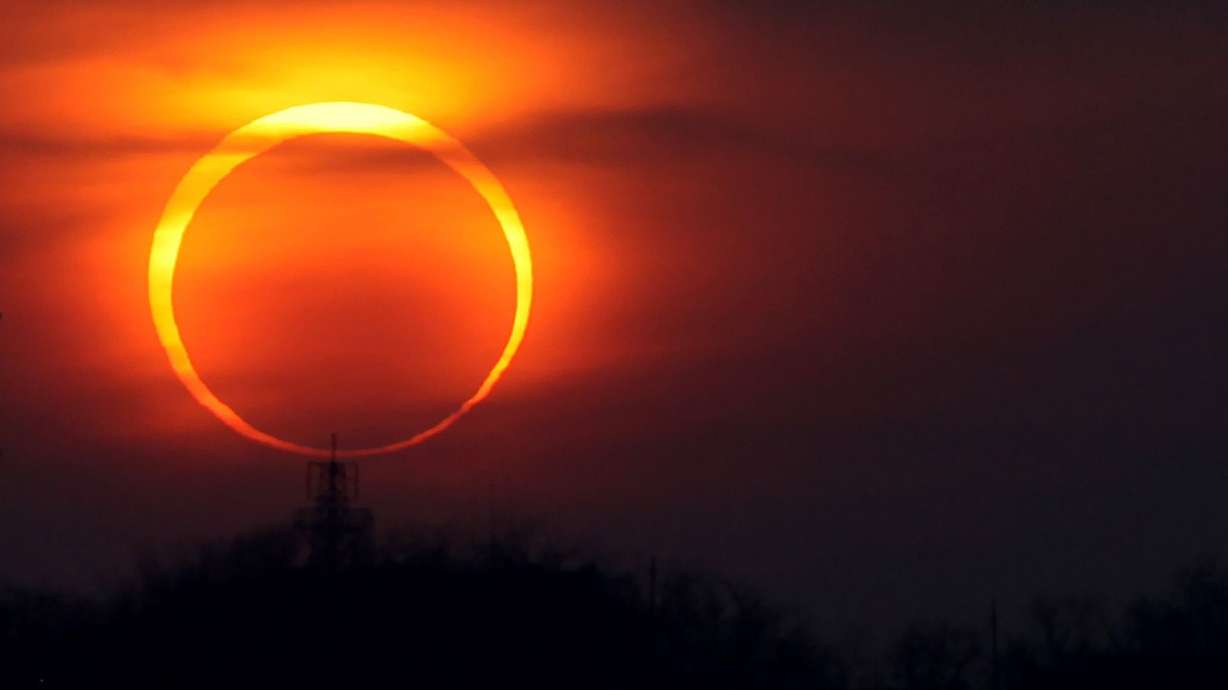Estimated read time: 5-6 minutes
This archived news story is available only for your personal, non-commercial use. Information in the story may be outdated or superseded by additional information. Reading or replaying the story in its archived form does not constitute a republication of the story.
SALT LAKE CITY — It hasn't happened in the western United States since 2012, and it won't happen again in Utah until 2039.
An annular solar eclipse is happening this weekend, and Utah is lucky to be in its direct path. KSL.com spoke with Weber State University professor John Armstrong about what an annular eclipse is, how long it will last and the best ways to watch it.
What is an annular solar eclipse?
An annular solar eclipse is not the same as a total eclipse, Armstrong said. He described an annular solar eclipse as similar to a total eclipse, in that the moon will be crossing the sun's path. But, while a total eclipse is when the moon completely covers the sun, an annular eclipse is partial coverage of the sun.
"The moon is on a slightly elliptical orbit: sometimes it's a little further away from us and sometimes it's a bit closer," Armstrong said. The distance is why the coverage of the sun can vary.
Annular eclipses happen during the new moon phase, but they don't happen visibly every month when there is a new moon because the sun, moon and Earth are on different orbital planes. This means their paths don't cross as often as a new moon happens.
"To have an eclipse coming through someplace where we can see it is actually kind of rare," Armstrong said. Eclipses happen more often than we are aware, but they are most frequently occurring over the ocean where no one can see them.
What time will it happen?
Armstrong said, "It starts crossing the sun at about a little after 9 in the morning" on Saturday. The moon being directly in front of the sun will happen for about four minutes, at or around 10:30 a.m. The moon will diminish the sun's light by about 90%.
"It's going to be a very eerie experience to have at 10:30 in the morning. Kind of sunset-like skies — it's not going to look like the sunset because it's not going to be reddish necessarily, but people will notice, even if you didn't know what's happening ... so, even if you don't have eclipse glasses, you will experience something cool," Armstrong said.
The moon will finish passing in front of the sun around noon.
Where can I watch it?
Utahns are lucky to be in the direct path of the annular eclipse this year. The eclipse can be seen from almost anywhere in the western states, though most areas will show only part of the shadow cast by the eclipse.
Richfield, in central Utah, is where the maximum eclipse will be able to be viewed — a phenomenon known as the "ring of fire" because of the way the sun's edges surround the moon perfectly.
Source: greatamericaneclipse.com
Snow College is holding a festival for the eclipse at its Richfield campus, with free solar viewing glasses and scientific activities.
The Utah Department of Transportation has extended a warning about high traffic moving toward central Utah in anticipation of the eclipse, as the state can expect around 300,000 visitors to the area on Saturday.
How can I watch it?
The easiest route, Armstrong said, is to get a pair of direct solar viewing glasses. Armstrong's advice when looking for the right glasses to buy is to be sure the glasses say "for direct solar viewing" — and, he said, never use the glasses while looking through a telescope.
No glasses? No problem. If you can find a leafy tree or bush where the leaves cross over each other, the shape of the sun can be seen in the plant's shadows due to pinholes created by the crossed leaves.
Armstrong said the sun is visible through these pinholes "all the time," but we don't notice them because we are so used to it.
"But when you have a big huge chunk of the sun taken out by the (moon), you will notice the shadows have a distinct shape — a crescent shape, or if you're in Richfield, they'll have the 'ring of fire'," Armstrong said.
What if I miss this one?
While the annular solar eclipse won't cross Utah's path again until 2039, there are more eclipses happening in other parts of the country and world.
Armstrong said the next total solar eclipse will pass through Texas and the Midwest in April next year. The last total solar eclipse was in 2017.
If eclipse chasers are willing to travel far, 2027 will see a total solar eclipse with maximum viewing in Luxor, Egypt.
How do eclipses benefit science?
Eclipses can be used to confirm theories about the universe. Armstrong's favorite eclipse story helped support the science of Albert Einstein.
"When Einstein came up with his theory of general relativity, he predicted that light would be bent by the gravity of the sun. That is a very hard thing to test, because if you look at the sun, you can't see the starlight behind it, so there's no way to tell if the starlight is being bent by the gravity of the sun — unless you wait for a total solar eclipse. In 1919, (scientists) did expeditions around the world to go measure this bending of light due to the sun. So, during the solar eclipse, the moon blocked out the sun and they could see all the stars around it. They measured the positions of the stars, and it was exactly as Einstein had predicted," Armstrong said.
For more information on Saturday's annular solar eclipse, visit the Utah Department of Natural Resources website.










